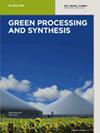多草药介导的 CuO 纳米粒子的简便绿色合成及其强效生物应用
IF 3.8
4区 工程技术
Q2 CHEMISTRY, MULTIDISCIPLINARY
引用次数: 0
摘要
利用阿育吠陀药七叶皂苷(septilin)合成了氧化铜纳米粒子(CuO NPs)。使用紫外-可见光谱、傅立叶变换红外光谱、X射线衍射(XRD)、扫描电子显微镜(SEM)和透射电子显微镜(TEM)对septilin介导的CuO NPs进行了表征。从 TEM 可见,CuO NPs 的平均粒径为 8 nm。CuO NPs 对大肠杆菌、绿脓杆菌、耐甲氧西林金黄色葡萄球菌(MRSA)和白色念珠菌的最小抑制浓度为 1-2.5 mg-mL-1。在 0.0315 至 2 mg-mL-1 的范围内,CuO NPs 可剂量依赖性地减少生物膜的形成,最高剂量为 2 mg-mL-1 时,铜绿假单胞菌、MRSA 和白色念珠菌的生物膜分别减少了 92.91%、79.84% 和 71.57%。通过扫描电镜分析还观察到使用纳米颗粒(NPs)处理后生物膜的减少。扫描电子显微镜分析还显示了经 NPs 处理后细菌和真菌细胞形态结构的变化和畸形。此外,还利用结肠癌(HCT-116)评估了 NPs 的抗癌功效。3-(4,5-二甲基噻唑-2-基)-2,5-二苯基溴化四氮唑试验清楚地表明了 NPs 的抗癌潜力,随着 CuO NPs 浓度的增加,存活细胞的数量减少。所制备的 CuO NPs 未来有望在许多生物和治疗领域开展研究,包括治疗微生物生物膜感染和抑制癌细胞生长。本文章由计算机程序翻译,如有差异,请以英文原文为准。
Facile, polyherbal drug-mediated green synthesis of CuO nanoparticles and their potent biological applications
Copper oxide nanoparticles (CuO NPs) were synthesized using ayurvedic medicine septilin. The septilin-mediated CuO NPs were characterized using UV–Vis, fourier-transform infrared spectroscopy, X-ray diffraction (XRD), scanning electron microscope (SEM), and transmission electron microscope (TEM). The average particle size of CuO NPs was 8 nm as evident from TEM. Minimum inhibitory concentration of CuO NPs against Escherichia coli, Pseudomonas aeruginosa, methicillin-resistant Staphylococcus aureus (MRSA), and Candida albicans was found in the range of 1–2.5 mg·mL−1. CuO NPs dose-dependently decreased the biofilm formation from 0.0315 to 2 mg·mL−1, at the highest dose of 2 mg·mL−1 of CuO NPs; 92.91%, 79.84%, and 71.57% decrease in biofilm was observed for P. aeruginosa, MRSA, and C. albicans, respectively. Down-regulation of biofilm upon treatment with nanoparticles (NPs) was also observed by SEM analysis. SEM analysis also showed the change in morphological structure, and deformities in bacterial and fungal cells upon treatment of NPs. Furthermore, the anticancer efficacy of NPs was assessed using colon cancer (HCT-116). The 3-(4,5-dimethylthiazol-2-yl)-2,5-diphenyltetrazolium bromide assay clearly showed the anticancer potential of NPs, as the concentration of CuO NPs increased, the number of viable cells decreased. The produced CuO NPs have promise for future investigations in many biological and therapeutic domains, including the treatment of microbial biofilm infections, as well as the inhibition of cancer cell growth.
求助全文
通过发布文献求助,成功后即可免费获取论文全文。
去求助
来源期刊

Green Processing and Synthesis
CHEMISTRY, MULTIDISCIPLINARY-ENGINEERING, CHEMICAL
CiteScore
6.70
自引率
9.30%
发文量
78
审稿时长
7 weeks
期刊介绍:
Green Processing and Synthesis is a bimonthly, peer-reviewed journal that provides up-to-date research both on fundamental as well as applied aspects of innovative green process development and chemical synthesis, giving an appropriate share to industrial views. The contributions are cutting edge, high-impact, authoritative, and provide both pros and cons of potential technologies. Green Processing and Synthesis provides a platform for scientists and engineers, especially chemists and chemical engineers, but is also open for interdisciplinary research from other areas such as physics, materials science, or catalysis.
 求助内容:
求助内容: 应助结果提醒方式:
应助结果提醒方式:


